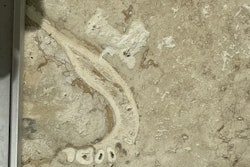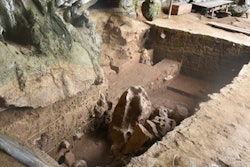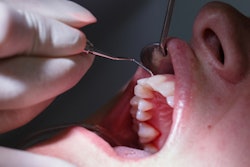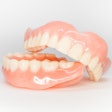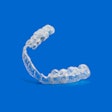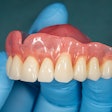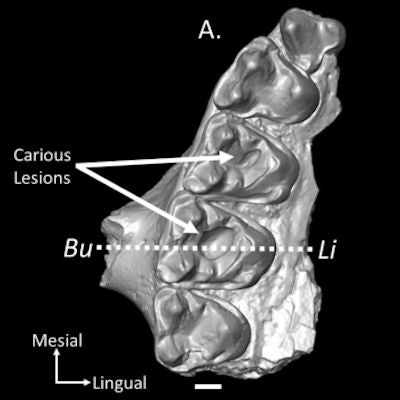
The oldest known evidence of caries in a mammal was found in the fossils of a monkeylike animal that lived 54 million years ago. A shift to higher-sugar foods likely caused the tooth decay, according to a study published on September 9 in Scientific Reports.
This is the first discovery of cavities in a fossil from an Early Eocene mammal, the stem primate Microsyops latidens. Also, it is the largest collection of individuals with caries for any fossil vertebrate taxon, the authors wrote.
"M. latidens underwent a dietary change resulting in an adaptive shift in the form of their teeth, and in the prevalence of dental disease," wrote the group, led by Keegan Selig, a doctoral candidate in the department of anthropology at the University of Toronto Scarborough in Ontario.
 (A) A micro-CT reconstruction of the right upper jaw fragment of M. latidens with carious lesions on the first and second molars. (B) A reconstruction of a slice through the caries in the second molar showing the internal morphology of the carious lesion. The slice is demarcated by the dashed line. All images courtesy of Selig et al. Licensed under CC BY 4.0.
(A) A micro-CT reconstruction of the right upper jaw fragment of M. latidens with carious lesions on the first and second molars. (B) A reconstruction of a slice through the caries in the second molar showing the internal morphology of the carious lesion. The slice is demarcated by the dashed line. All images courtesy of Selig et al. Licensed under CC BY 4.0.M. latidens roamed the Earth for about 500,000 years before the species became extinct approximately 54 million years ago. These stem primates, which means they have no living descendants, were thought to be omnivores that relied mostly on leaves and fruits for their diet. The animals can be identified by their spearhead-shaped lower central incisors, and their fossilized teeth have been unearthed from the Willwood Formation of the southern Bighorn Basin of Wyoming for decades, according to the authors.
To better understand the small holes and damage that could be seen in the fossilized teeth, Selig and colleagues examined them under a microscope. They identified the pits and fissures as cavities and reconfirmed them using micro-computed tomography (CT) reconstructions, they wrote.
The researchers identified caries in 77 of the 1,030 individual fossil samples, or about 7.5% of the total. There was a notable variation depending on the specific time period in which these animals lived. During certain intervals, the prevalence of dental caries in M. Latidens reached 17.4%, the authors wrote.
 (A, B) Micro-CT reconstructions of lower right jaw fragments. (C, D) Reconstructions of upper right jaw fragments. In each tooth, the caries is primary and located in the occlusal basin. Black arrows denote the carious lesions. Scale bar = 1 mm.
(A, B) Micro-CT reconstructions of lower right jaw fragments. (C, D) Reconstructions of upper right jaw fragments. In each tooth, the caries is primary and located in the occlusal basin. Black arrows denote the carious lesions. Scale bar = 1 mm.The evidence suggests the animals began eating more fruit or other sugar rich-foods for a short period of time. Though it is difficult to determine why their diet shifted, it is well documented that there was climate change during the Early Eocene period. Increasing and decreasing temperatures may have affected the availability of certain foods, they wrote.
"Our results suggest that caries frequency was high at times in the past among Microsyops latidens, with large proportions of individuals afflicted by the disease in particular intervals of time," Selig and colleagues concluded.





